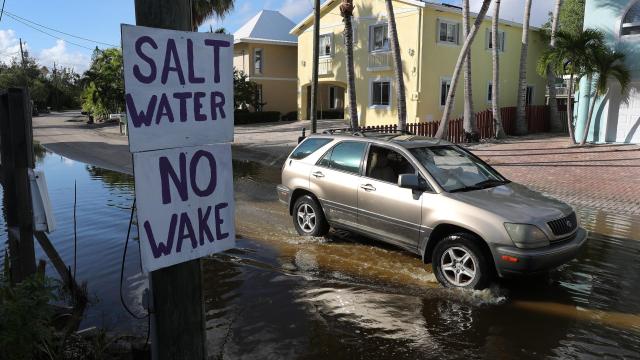Sea levels on U.S. coastlines are expected to rise an average of 10 to 12 inches by 2050, according to a new report led by the National Oceanic and Atmospheric Administration (NOAA). It’s the latest jarring assessment of how climate change is disrupting life as we knew it.
The news is NOAA’s addendum to the massive report produced by the Intergovernmental Panel on Climate Change (IPCC) last summer. That report found that droughts, storms, and heatwaves are happening more frequently and will continue to increase. It also put the matter of sea level rise in stark terms.
Bob Kopp, an IPCC co-author and director of the Rutgers Institute of Earth, Ocean and Atmospheric Sciences, told reporters at the time that “sea level rise is already impacting people around the world, and it’s led to a near doubling in the frequency of coastal flooding since the 1960s in many coastal sites around the world.” The new NOAA report merely affirms that people living in the United States will similarly be affected by the global shifts caused by greenhouse gas pollution.
Sea level rise in the United States is anticipated to vary by region, the report said; on the Gulf Coast, water levels could rise by a terrifying 18 inches. Besides that disastrous conclusion, the report projects that moderate flooding (“typically damaging,” NOAA notes) will occur more than 10 times more often than it does today, and major (“often destructive’’) flooding will be five times as frequent. If we are to change those projections, we’re going to have to do things differently.
2050 might feel far away. But last year alone, 20 weather or climate disasters cost the United States $US1 ($1) billion in damages, not to mention vast human suffering. Rising seas are already affecting American coastlines, perhaps most visibly in the metropolises along the Florida coast, where king tides routinely gurgle up from below, inundating city streets. If you’re having trouble imagining what that rise could look like going forward, here’s a helpful visualisation of sea level rise in different cities around the world.
While the report is a jarring reminder of climate change’s immediacy and severity, how quickly we take action does matter. Thanks to emissions we’ve already put into the atmosphere, 0.61 m of sea level rise is “increasingly likely between 2020 and 2100,” the NOAA report notes. That sounds bad, but it can always get worse. If we don’t take action to seriously curb emissions now, the Greenland and Antarctic ice sheets could be seriously affected with increased warming. Ice sheet projections are difficult to model, but in a worst-case scenario, increasing temperatures could add an additional 0.5 to 1.5 metres of rise to what we can currently expect — meaning sea levels could rise a total of between 1.1 and 2.1 metres by 2100. That’s a much different world than the one we live in now.
